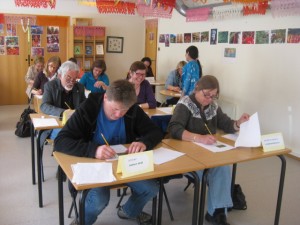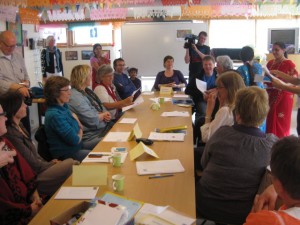Building a house of diversity
Learning is a lifelong process but it is challenging for immigrants who come from an entirely different cultural background to learn the culture and language of the new country and to get integrated among native people. The complication in integration for Asians is very high in Europe where culture, tastes, social system and daily behavior widely vary. Bhutanese refugees resettled in Norway presented their difficulties though a drama-like session.
For Bhutanese refugees, being resettled in Europe is a tough task yet it’s an overwhelming experience. Some of the Bhutanese refugees resettled in south-west Norway recently participated in the Gruntvig Project activities, which works for raising awareness among the local people about their view towards new immigrants in their settlement area.
Gruntvig Project has been trying to turn these challenges into opportunity for the natives and the settlers and for local policy makers to learn how difficult it is for those people in acquiring the basic skills and getting acquainted with a new way of living. The project has been working in seven different European countries including Norway, Denmark and The Netherlands where about eight hundred Bhutanese have made their new home presently.
Participants from one elderly language center from each of these countries were given opportunity to intermingle and exchange the difficulties they have been facing, with funding from European Union (EU). Bhutanese refugees became part of the intermingling through Tysværopplæringssenter of Norway.
The language center, where Bhutanese go for learning Norwegian, was totally decorated in a Bhutanese style aiming to make it resemble a place in southern Bhutan. Pictures, maps, placards, things made of coloured papers, different utensils, dress, articles of cultural importance and books on Bhutan were on displayed. Traditional Bhutanese tea was served.
The drama
Interview began. Participants could know about their turn just by listening to their names. For the particular day, they were immigrants to southern Bhutan where they were to live and work. They were to learn the language and get used to with the long practiced culture and tradition. There were several questions. Everybody was uncertain about what they will be doing in near future. The interview was meant to show the state of newly arrived immigrants to a new country.
All the instructions were given in Nepali. Speaking Norwegian was restricted for the period. Participants would turn mute as the instructions were given. This proved that the language was more than anything for anybody.
Learning a new language is a real challenge. Different sounds in different languages, language mechanics and grammar and many others are determinants in learning a new language. This can be exceptionally wearisome for illiterates and for those who come from families, whose members belong to different linguistic groups. This was clearly seen during the course of Nepali teaching though the participants coped up the situation much easily, being learned, and could translate the pronunciations into their mother tongue.
A course in social skills could give a little insight of the typical culture in southern Bhutan. Information about housing, food, daily life, Bhutanese hospitality, school system, administration was given. Though the participants were supposed to be in Bhutan, many raised questions about the exodus of one hundred thousand people from this little kingdom. Some sentences about hypothetical philosophy of Gross National Happiness contributed a little to judge the other side of Bhutan. For many in Norway, Bhutan is the land of “Happiness” and mountain range.
The expression by the participants in the round table interview showed that many could experience the difficulties one encounters while being in a new country. Many participants also revealed that they could collect some information on aspects of living in southern Bhutan and many commented to further conduct the programme in a regular basis.
Conclusion
Immigrants face several sorts of complications as they first come to a new, developed and technology-driven country like Norway. Norwegian culture had not been amalgamated for centuries and therefore, it is reserved in nature to some extent. First entrants were Pakistanis who came to Norway as labour immigrants in 1970s. After this, refugees and asylum-seekers are entertained to a considerable degree. This has helped in changing the attitude of the common people to think immigration as a common phenomenon. Nevertheless, many problems and complications persist in practice for immigrants. The first thing that all must take not of is the integration. An arrangement like this helps everybody understand the challenges of the immigrants and in fact, motivates immigrants for getting integrated into the Norwegian society. “Building a House in Diversity” proved to an important event for Bhutanese.


